What is a headless CMS?
30 Jul 2024

What is a headless CMS?
A headless CMS is the only background content management system (CMS) built from the ground up as a repository of content that makes content accessible via the RESTful API or GraphQL API for display on any device.The word "headless" comes from the idea of determining "head" (front, i.e. website) "body" (back border, i.e. content repository). The headless CMS comes with a visual content management interface and a RESTful or GraphQL API to deliver content wherever you need it. Because of this approach, a headless CMS does not care how and where your content will be displayed. It only focuses on: maintaining and delivering organized content and allowing content editors to participate in new content.
A headless content management system partner is often referred to as a monolithic, standard or integrated CMS.
Let's take a look at the Monolithic CMS and its feature set:
- Content reading and writing content website.
- Administrator interaction to allow editors to manage content.
- Integration of literacy.
- A real front that integrates data from a website with HTML.

Without the use of a standard / monolithic CMS, a website cannot be built solely with a headless CMS. The headless CMS has separated the head from its stack so it does not have this point in its design. Therefore, the developer must create the website himself and use the REST or GraphQL APIs so that the CMS is headless to access the content.
Creating a whole website yourself seems like a big task on the list, but by separating the CMS from scratch the developer can choose any technology they are already familiar with and does not need to learn the technology of that particular CMS.
Another nice bonus is the fact that one engineer can focus on his or her work without having to deal with existing technology bugs - so it's easy to set up webpages and webvitals and restart website components or create broken technologies. decision without worrying about losing existing content.







